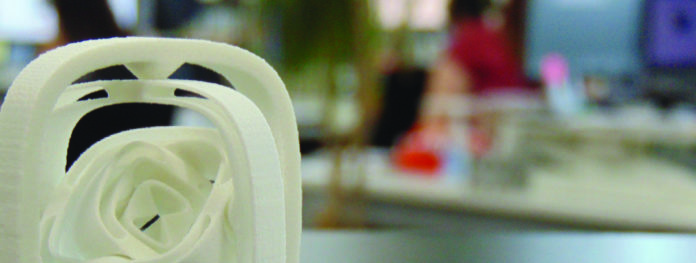Based on its Variable Acoustic Displacement™ (VAD) technology, PostProcess Technologies Inc. has unveiled a new automated polymer powder removal solution.
This patent-pending solution for the gross depowdering (decaking) of selective laser sintering (SLS) and multi-jet fusion (MJF) 3D printed parts is focused on unlocking production volumes through automated, software-driven technology.
Currently, the gross depowdering process for 3D printed polymer parts is encumbered with excessive labor and part breakage. Common processing methods are highly manual or semi-automated, using vacuums or blasting high-pressure air for removing powder. Such approaches are not well-suited to the unique and complex geometries for which additive is utilized, nor capable of enabling production volumes. The opportunity to scale with these traditional depowdering methods is limited as they are unable to support end-to-end digitalization by providing closed-loop feedback for the complete additive manufacturing workflow. Additionally, these methods can expose operators to loose powder, resulting in workplace safety hazards and airborne particle exposure.
PostProcess’s newest technology family, Variable Acoustic Displacement™ (VAD), employs its AUTOMAT3D® software platform to optimize mechanical energy combined with intelligent closed-loop thermal and displacement techniques to reduce cycle times while increasing part fidelity.
The same software platform is used with its automated SLA resin removal. As a reminder, the process is thermodynamically controlled with both video and infrared monitoring while releasing, transferring, and recovering loose powder particles in a hands-free manner. Software-tuned frequencies identify geometries while sound (pressure) waves function as a non-destructive mechanical energy source to de-cake powder. These functions are automatically monitored and adjusted in real-time in a closed-loop solution that repurposes powder for optimal sustainability.
The VAD solution is also enabled for production scale via integration with PostProcess’s CONNECT3D™ software. The CONNECT3D platform, currently in beta, allows users to operate and monitor their fleet of PostProcess solutions from anywhere, optimizing finishing per part design and enabling real-time planning and decision-making. VAD complements PostProcess’s existing portfolio of software-driven solutions for resin removal, support removal, and surface finishing across a range of 3D print technologies, both polymer, and metal.
After successful validation of the VAD technology was performed with selected customers, the company is expanding its initial availability before the solution reaches global commercial release. Regarding the launch, Daniel J. Hutchinson, inventor of the VAD patent-pending technology and Founder/CTO at PostProcess Technologies, said, “We have a strong team commitment to developing solutions that will enable the scalability of the market, and partnerships with early access customers will help ensure technology alignment to market needs. PostProcess is not only expanding its portfolio to better serve those using powder applications, but we are making material reuse easier and unleashing a more sustainable future for the additive manufacturing industry.”
Remember, you can post free of charge job opportunities in the AM Industry on 3D ADEPT Media or look for a job via our job board. Make sure to follow us on our social networks and subscribe to our weekly newsletter : Facebook, Twitter, LinkedIn & Instagram ! If you want to be featured in the next issue of our digital magazine or if you hear a story that needs to be heard, make sure to send it to contact@3dadept.com






